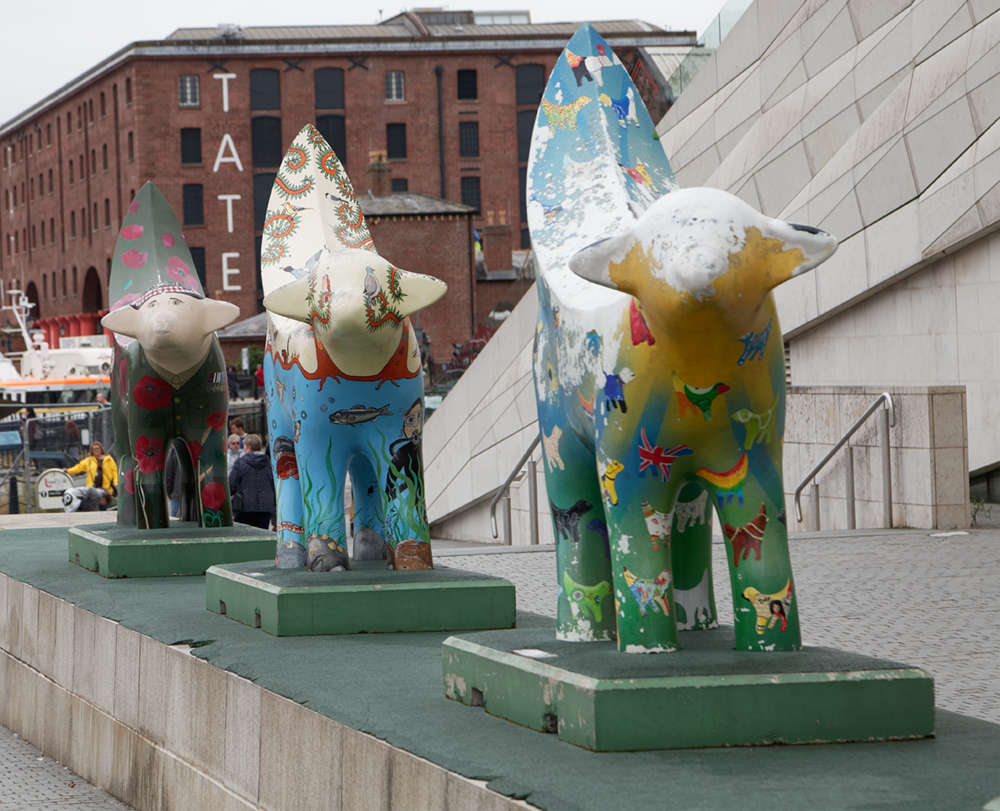When wandering around the Mersey Estuary, one unexpected pleasure is the wealth of outdoors art to appreciate in Liverpool, Wirral and beyond.
Liverpool
Starting to the north of Liverpool, the world-famous Another Place installation stretches for about two miles along Crosby Beach. Consisting of a hundred life-size cast iron figures facing out to sea, it became a permanent feature in 2005 after being exhibited in Belgium, Germany and Norway. Their creator, Sir Anthony Gormley, said:
In this work, human life is tested against planetary time. This sculpture exposes to light and time the nakedness of a particular and peculiar body, no hero, no ideal, just…
…the industrially reproduced body of a middle-aged man trying to remain standing and trying to breathe, facing a horizon busy with ships, moving material and manufactured things around the planet.
Sir Anthony’s other credits include the Angel of the North statue in Gateshead and seven more iron men along Edinburgh’s main river, the Water of Leith.
In Liverpool itself, visitors to the waterfront are often surprised to see a collection of superlambananas, which as the name suggests take their design cues from the unusual combination of a lamb and a banana. These are replicas of an original design by Taro Chiezo and were created for the European Capital of Culture celebrations in 2008; the much larger original is situated on Vauxhall Road near Moorfields Station.
Heading south, on Otterspool Promenade, another unusual sight on the estuary shores is the Sitting Bull statue, originally created for the Liverpool International Garden Festival of 1984.
Wirral
Across the water on the Wirral lies the New Brighton Mermaid Trail. This is based on an 18th century legend and the five sculptures were created by the Wirral-based sculptor Barry Canning-Eaton.
Nearby, the Black Pearl is another community led project, built from driftwood in the form of a pirate ship, which occasionally needs rebuilding after the battering from the wind and tides.
Heading south, in Birkenhead, there are several plaques and sculptures along the Wirral Maritime Heritage Trail, which commemorate the sacrifices made by mariners from the region, including at Eastham Ferry and near Woodside Ferry Terminal.
Widnes and Runcorn
Further up the estuary, one of the most unusual installations is a 14 metre high tower at Widnes Warth, designed by architects Tonkin Liu. Called Future Flower, it has leaves made from metal and lights powered by wind generators. The Warth – meaning a look-out point or a bend in a river in Old English – is a picturesque area along the banks of the Mersey, with birds hides looking out across the mudflats exposed at low tide.
On the opposite shores, at Runcorn Hill Park, an interesting small collection of sculptures includes a dramatic bearded figure, possibly representing a king or chieftain.
Other places to see outdoor art in this part of the estuary include the Sandstone Trail, which begins in Frodsham, and in Hale village, where there is a statue commemorating a famous former resident: the Hale Giant.
Museums and art galleries
There are of course also many museums and art galleries around the estuary, of which perhaps the most famous is Tate Liverpool at Royal Albert Dock in Liverpool.
Other important collections include those at the Walker Art Gallery near Liverpool Lime Street Station, the Williamson Art Gallery & Museum near Birkenhead and the Lady Lever Art Gallery in Port Sunlight.
Further east, Warrington Museum & Art Gallery has a fine display of paintings from contemporary and international artists.
If you enjoyed this post and would like to learn more about the history, environment and wildlife of estuaries, I also produce a monthly newsletter, for which sign up details are below.
Also, to find out more about the various sites mentioned here, The Mersey Estuary: A Travel Guide, describes places to visit nearby along with walks and cycle rides and insights into the history, environment and wildlife of the estuary. The following links give more information.
The Mersey Estuary: A Travel Guide
The book was published in 2020 and is available in paperback and as an ebook from most bookstores and online retailers. See www.troubador.co.uk for more information, including a short video about the book.

